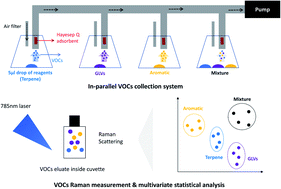当前位置:
X-MOL 学术
›
Anal. Methods
›
论文详情
Our official English website, www.x-mol.net, welcomes your feedback! (Note: you will need to create a separate account there.)
VOCs determination by adsorbent-Raman system in food and botanicals
Analytical Methods ( IF 3.1 ) Pub Date : 2020/03/10 , DOI: 10.1039/d0ay00180e Jinhyuk Park 1, 2, 3, 4 , J. Alex Thomasson 1, 2, 3, 4 , Kyung-Min Lee 3, 4, 5, 6, 7 , Charles P.-C. Suh 3, 4, 8, 9, 10 , Jose L. Perez 3, 4, 8, 9, 10 , Timothy J. Herrman 3, 4, 5, 6, 7
Analytical Methods ( IF 3.1 ) Pub Date : 2020/03/10 , DOI: 10.1039/d0ay00180e Jinhyuk Park 1, 2, 3, 4 , J. Alex Thomasson 1, 2, 3, 4 , Kyung-Min Lee 3, 4, 5, 6, 7 , Charles P.-C. Suh 3, 4, 8, 9, 10 , Jose L. Perez 3, 4, 8, 9, 10 , Timothy J. Herrman 3, 4, 5, 6, 7
Affiliation

|
Volatile organic compounds (VOCs) emitted from foods and plants are typically analyzed by gas chromatography/mass spectrometry (GC/MS) or electronic-nose (E-nose) analysis. GC/MS is highly sensitive but lacks portability, while E-nose equipment is portable but has a narrow range of analysis. In this study, a Raman-based VOC detection system was developed along with multivariate analysis for spectral differentiation of VOCs. A 5 μL droplet each of four representative VOCs (linalool, cis-3-hexenyl acetate, cis-3-hexen-1-ol, methyl salicylate) was pre-concentrated with Hayesep Q adsorbent in a sealed chamber. After a given collection time (20 and 60 min), Raman spectroscopy was used to measure the VOC eluates from each adsorbent. Two collection times were tested, and single VOCs versus VOC mixtures were compared. Finally, Raman spectral data were processed with baseline correction and normalization and analyzed with unsupervised and supervised learning techniques. After 20 minutes of collection, individual and mixed volatiles showed unique spectral features, and the multivariate techniques produced good discrimination among the VOCs. Raman spectroscopy was also used to measure mixtures containing three VOCs at five different concentrations, and when principle component regression was applied, a concentration–estimation curve with a high R2 of 0.953 was generated. This system developed on VOC standards was tested on two types of tea (black and earl grey) to determine the differentiability of tea aromas, and several unique Raman spectra were observed from the tea samples. Therefore, the proposed Raman technique has proven to be effective at fast screening of multiple VOCs given off from foods and plants and is a good candidate for fast and portable applications.
中文翻译:

用食品和植物中的拉曼吸附剂系统测定挥发性有机化合物
从食物和植物中散发出的挥发性有机化合物(VOC)通常通过气相色谱/质谱(GC / MS)或电子鼻(E-nose)分析进行分析。GC / MS具有很高的灵敏度,但缺乏便携性,而E-nose设备是便携式的,但分析范围狭窄。在这项研究中,开发了基于拉曼的VOC检测系统以及用于VOC光谱区分的多变量分析。在密封室中用Hayesep Q吸附剂对4种代表性VOC(芳樟醇,顺式-3-己烯基乙酸酯,顺式-3-己烯-1-醇,水杨酸甲酯)的5μL液滴进行预浓缩。在给定的收集时间(20和60分钟)后,使用拉曼光谱法测量每种吸附剂的VOC洗脱液。测试了两次采集时间,并测试了一次挥发性有机化合物对比VOC混合物。最后,通过基线校正和归一化处理拉曼光谱数据,并使用无监督和有监督的学习技术进行分析。收集20分钟后,单个挥发物和混合挥发物显示出独特的光谱特征,而多元技术对挥发性有机化合物具有良好的区分度。拉曼光谱法还用于测量包含五个不同浓度的三种VOC的混合物,当应用主成分回归法时,R 2值较高的浓度估计曲线产生了0.953。在两种类型的茶(黑和伯爵茶)上测试了基于VOC标准开发的系统,以确定茶香气的可区分性,并且从茶样品中观察到了几个独特的拉曼光谱。因此,事实证明,提出的拉曼技术可有效筛查从食品和植物中释放出的多种挥发性有机化合物,是快速,便携式应用的理想选择。
更新日期:2020-03-27
中文翻译:

用食品和植物中的拉曼吸附剂系统测定挥发性有机化合物
从食物和植物中散发出的挥发性有机化合物(VOC)通常通过气相色谱/质谱(GC / MS)或电子鼻(E-nose)分析进行分析。GC / MS具有很高的灵敏度,但缺乏便携性,而E-nose设备是便携式的,但分析范围狭窄。在这项研究中,开发了基于拉曼的VOC检测系统以及用于VOC光谱区分的多变量分析。在密封室中用Hayesep Q吸附剂对4种代表性VOC(芳樟醇,顺式-3-己烯基乙酸酯,顺式-3-己烯-1-醇,水杨酸甲酯)的5μL液滴进行预浓缩。在给定的收集时间(20和60分钟)后,使用拉曼光谱法测量每种吸附剂的VOC洗脱液。测试了两次采集时间,并测试了一次挥发性有机化合物对比VOC混合物。最后,通过基线校正和归一化处理拉曼光谱数据,并使用无监督和有监督的学习技术进行分析。收集20分钟后,单个挥发物和混合挥发物显示出独特的光谱特征,而多元技术对挥发性有机化合物具有良好的区分度。拉曼光谱法还用于测量包含五个不同浓度的三种VOC的混合物,当应用主成分回归法时,R 2值较高的浓度估计曲线产生了0.953。在两种类型的茶(黑和伯爵茶)上测试了基于VOC标准开发的系统,以确定茶香气的可区分性,并且从茶样品中观察到了几个独特的拉曼光谱。因此,事实证明,提出的拉曼技术可有效筛查从食品和植物中释放出的多种挥发性有机化合物,是快速,便携式应用的理想选择。


























 京公网安备 11010802027423号
京公网安备 11010802027423号